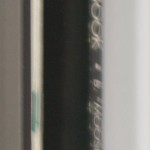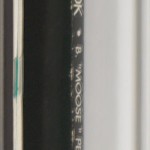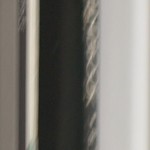“Vibration Reduction”; Nikon’s tradename for optical image stabilization. The camera and lens sense the degree of camera motion, and deflect elements in the lens to cause counter-vailing motions, resulting (if it all works right) in a sharper image. They claim about a 3-stop improvement (in terms of lower shutter speeds usable hand-held).
The rule of thumb is that you can safely hand-hold the camera down to a shutter speed of 1/(focal length). This is a 35mm rule of thumb, and it’s the 35mm-equivalent focal length that matters here. So for a 200mm lens on a full-frame DSLR, the safe shutter speed (by rule of thumb) is 1/200 sec. Or, with VR, about 1/30.
The following test photos are small crops from the center of the frame, containing the focus point. They were all shot hand-held, free-standing (I wasn’t leaning against anything).







I score that as 1 and 2 acceptably sharp, the rest not.
And now some examples shot with VR off.








None of the VR off examples are acceptably sharp.
So; the VR off case certainly works as expected, no hope. The VR case produced two acceptably sharp photos a full 4 stops below where it should have been okay by rule of thumb. And a lot of failures, but I was seriously pushing the limits here.
Next post will be another run, a bit more careful, with 10 shots of the same test subject for each series. But this is getting long enough and ugly enough as it is.